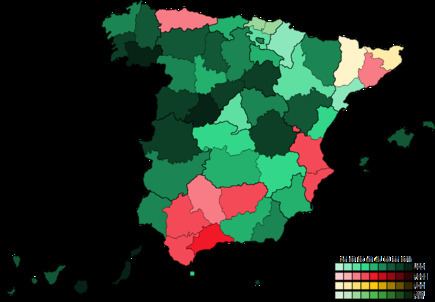15 June 1977 1979 → Turnout 18,590,130 (78.8%) 13 October 1974 3 July 1960 Start date June 15, 1977 | Registered 23,583,762 3 May 1977 13 October 1974 165 118 | |
 | ||
Winner Adolfo Suárez | ||
The spanish transition electoral manifesto of su rez udc for the 1977 elections eng e esp
The 1977 Spanish general election was held on Wednesday, 15 June 1977, to elect the Constituent Cortes Generales of the Kingdom of Spain. All 350 seats in the Congress of Deputies were up for election, as well as all 207 seats in the Senate. It was the first election since the death of Francisco Franco. The previous general election was held in 1936, prior to the outbreak of the Spanish Civil War.
Contents
- The spanish transition electoral manifesto of su rez udc for the 1977 elections eng e esp
- Electoral system
- Opinion polls
- References
The elections took place against the backdrop of a poor economic situation in Spain. They were marred by demonstrations against alleged irregularities and bombings in many areas. In Barcelona, 2,000 demonstrators gathered outside the building housing the local election board. They claimed they had not been included in the census, which would have given them the right to vote. Two policemen were also hurt when a Molotov cocktail was thrown at their vehicle. In Seville, three people, including two policemen, suffered minor injuries when a bomb exploded at the magistrates' court. Additionally four explosions occurred in Pamplona and two in Cordoba.
The election results were a disappointment for the Communist Party, which fell short of its goal of 30 to 40 deputies.
Post election the Union of the Democratic Centre governed in a minority, working with other opposition parties from both sides of the political spectrum including the rightist People’s Alliance and the parties of the left, the Spanish Socialist Workers' Party (PSOE) and Communists (PCE).
Electoral system
The Spanish Cortes Generales were regarded as an imperfect bicameral system under the 1977 Political Reform Act, which envisaged a provisional legislature that was to approve a new constitution in a short time-span. Initiative for constitutional amendment belonged to the Congress of Deputies—as well as to the Government—and required of the approval by an absolute majority in both the Congress and Senate. Ultimately, in the event of a deadlock a joint sitting of both chambers would convene as a single legislative body in order to resolve on the issue by an absolute majority. No electoral law was in force at the time, with election rules for both chambers regulated under a provisional decree.
For the Congress of Deputies, 348 seats were allocated to 50 multi-member districts—each corresponding to a province—, elected using the D'Hondt method and a closed list proportional representation. Ceuta and Melilla elected one member each using plurality voting, for a total of 350 seats. Each district was entitled to an initial minimum of two seats, with the remaining 248 allocated among the 50 provinces in proportion to their populations. A threshold of 3% of valid votes—which included blank ballots—was applied in each constituency, with parties not reaching the threshold not taken into consideration for seat distribution.
For the Senate, each of the 47 peninsular constituencies was allocated four seats. For insular provinces, such as the Balearic and the Canary Islands, districts were the islands themselves, with the larger—Majorca, Gran Canaria and Tenerife—being allocated three seats each, and the smaller—Menorca, Ibiza-Formentera, Fuerteventura, La Gomera-El Hierro, Lanzarote and La Palma—one each. Ceuta and Melilla elected two seats each, for a total of 207 directly elected seats, using an open list partial block voting. Instead of voting for parties, electors would vote for individual candidates. In districts electing four seats, electors could vote for up to three candidates; in those with two or three seats, for up to two candidates; and for one candidate in single-member constituencies. Additionally, the King could appoint senators in a number not higher than one-fifth of the elected seats, increasing the Senate size to a maximum of 248.
Voting was on the basis of universal suffrage, with all nationals over twenty-one and in the full enjoyment of all civil and political rights entitled to vote. Concurrently, nationals meeting the previous criteria and not involved in any cause of ineligibility were eligible for both the Congress and the Senate. Groups of electors were required to obtain the signatures of at least 1/1000 of registered electors—provided that this amount did exceed of 500—in a particular district in order to be able to field candidates.
Opinion polls
Individual poll results are listed in the table below in reverse chronological order, showing the most recent first, and using the date the survey's fieldwork was done, as opposed to the date of publication. If such date is unknown, the date of publication is given instead. The highest percentage figure in each polling survey is displayed with its background shaded in the leading party's colour. In the instance of a tie, the figures with the highest percentages are shaded. Seat projections are displayed in bold and in a different font. The lead column on the right shows the percentage-point difference between the two parties with the highest figures. 176 seats were required for an absolute majority in the Congress of Deputies.
